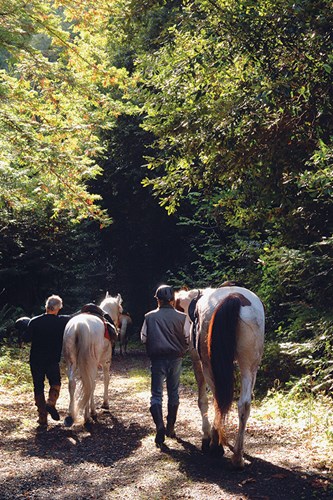
After a long ride, do you ever dismount so awkwardly you hope no one is looking? Perhaps you kick both feet free of the stirrups, drag your right leg over, then lower yourself to the ground while holding onto the saddle horn, gritting your teeth, finally taking a few tentative, painful steps.
We ride the trails for pleasure. Time in the saddle on our favorite mounts is our addiction. But at what point does the pain outweigh the pleasure? How can we enjoy our favorite activity, particularly as we age, without suffering both on the trail and in subsequent days?
Well, we need to overcome some shortcomings of our anatomy, select our gear carefully, and even consider choosing just the right horse to minimize the pain.
In terms of our anatomy, humans walked for eons before they domesticated the horse. Our bodies are “designed” for walking, running, sitting, and perhaps even squatting, but not for straddling a
horse, particularly when the horse subjects us to concussion with every step.
Here, I’ll go over typical problem areas — knees, pelvis/seat, hands, and back — with suggestions for modifying their tendency to dampen our fun.
The Knees
Knees are the most common trouble areas, which is completely understandable when you consider they’re basically hinges made to flex in just one way.
Standing vertically, our knees allow the lower legs to arc straight to the rear, not forward nor to the side. When you straddle your horse, your knees are asked to bend to the side along his rounded rib cage, which is impossible! Thus, the strain.
Experimenting with stirrup length can help, although there’s no really “correct” length to minimize knee strain.��The cattlemen of Spain’s Alpujarra Mountains ride with stirrups so short I winced when I watched them wend their way up the mountain trails. But they’re used to that length — it feels right to them, and their muscles have adjusted over time.
I tend to do better with stirrups rather long, so that standing in them results in only two or three inches of daylight between my body and the saddle.
A saddle with relatively free-swinging stirrups can also help, because your feet can project forward on downhill grades, keeping your legs straighter and avoiding pressure on the fronts of your knees.
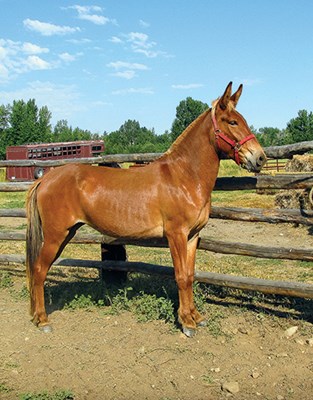
But a horse with a narrow build is one of the best friends your knees can have. Riding such a horse avoids much of the lateral pressure on your knees and allows your legs to
support you in a straighter position.
Since horses with deep, narrow builds tend to have an edge in endurance, they have additional advantages. I also suspect that one reason for mules’ reputation as easy-riding animals lies in their narrower builds.
I realize that part-draft horses are now very popular for riding, and it’s understandable — such breeds so often have loveable dispositions.
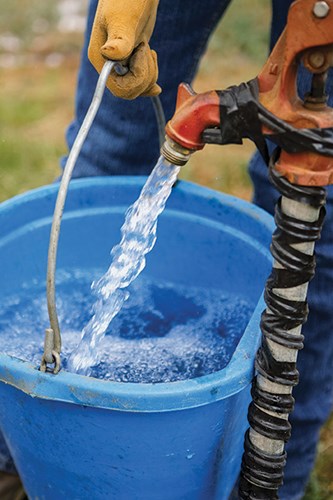
I have three Belgian/Tennessee Walking Horse crosses I dearly love, but they pull a wagon — I wouldn’t consider a day in the saddle on one of their large, rounded torso. My leg muscles and knees, now stiff with age, simply wouldn’t allow it.
The Pelvis/Seat
If a long day’s ride makes it difficult for you to enjoy a hard chair the next day, you might consider exercises to strengthen your legs.
To save your seat the old rule of thumb was that you should exert a force of approximately
one-third of your weight on the stirrups as you ride.
So, if you weigh 150 pounds, the downward pressure your feet exert when you stand, perhaps 50 pounds, should be pressuring downward as you ride.
This not only makes your seat more secure, but also allows your legs to absorb some of the concussion so that your seat doesn’t have to take it all.
When you see riders with legs that appear loose, it’s likely virtually all their weight is on their seat. They’re in a topheavy position, dangerous in case of a spook, and their pelvic and seat areas will
likely be sore in the morning.
If your seat tends to get sore no matter what you do, consider a seat saver — a padded cushion you attach to the saddle seat.
I’d never heard of a seat saver until I tend to avoid them in the rough weather of fall and winter hunting camps, because some are padded with open-cell foam that can absorb water, then freeze
hard as a rock.
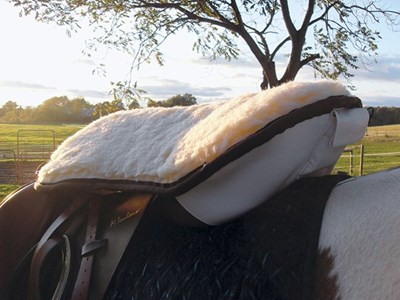
The Hands
On long rides, the mere act of holding the reins can create numbness, just as repetitive work with a computer mouse can give rise to carpal tunnel syndrome. One reason I advocate slim leather
reins, rather than the rope reins so popular today, is that they feel nearly weightless held in one hand on a responsive horse trained to neck rein.
However, when I lead a pack horse, I prefer to hold his lead rope in my right hand and the reins in my left. A soft cotton lead is easy on my hand, though terrible in freezing weather, should it get wet and
be left overnight. Eventually, my hand gets numb, even with a soft rope.
Draping the lead over the horn then down where I can tuck it under my knee is safe, because any slippage signals the need to grasp the rope again. This relieves my hand on terrain that’s relatively safe.
Never tie your pack horse’s lead fast to the saddle horn or take more than a single dally (wrap) around the horn.
The Back
Virtually everyone who works hard in life (and many who do not) will eventually have back problems. Compression on your spine takes its toll over the years. Discs slip slightly out of place, arthritis builds, nerves get compressed.
Back problems are varied and too complex for much comment from a layman like me. But I’ve become more aware of a couple of them. A friend’s riding has been affected by spinal stenosis, a restriction of the opening for the spinal cord, which applies pressure to the nerve, and causes pain
in the backs of her upper thighs and buttocks, thus making riding less attractive. The jury is still out on whether surgery will be required.
I’ve faced compression on the sciatic nerve on my right side, which has tended to cause numbness in that leg on long rides, particularly downgrade. Barring rather invasive measures, it’s something I have to live with.
All riding soreness can be moderated by improving your fitness level and choosing the right mount; here are a few suggestions in both areas.
Improve Your Fitness
Yes, it’s tiresome to continually hear this, but good overall physical conditioning
makes everything better.
Our skeletons are held together by sinews and muscles. The stronger the muscles, the more support for our bones. When contemplating long (and hopefully enjoyable) rides, nothing helps more than a routine that alternates aerobic exercise with weight resistance.
Leg strength is particularly important. It’ll help you mount and dismount, take some weight off your seat, and possibly save a spill in case of a spook or buck.
Most of us (I’m guilty, too) carry more weight around than we really need. When I see a truly obese person horseback, I wince for the well-being of the horse and also for the person’s safety. People who are extremely overweight rarely have the leg strength to properly support their bulk. They’re topheavy in the saddle, and that’s dangerous.
I once had the gall to tell a prospective customer that she should forget riding lessons and head for a gym. I couldn’t believe I’d blurted that out, and I was certain I’d lost a customer and a prospective friend. Fortunately, it didn’t turn out that way — she lost 40 pounds, and her riding improved 100
percent.
Nothing is kinder to your body on a long ride than occasionally dismounting and leading your horse up the trail. Don’t just stand next to your horse and stretch. Walk briskly for five minutes every hour.
If the grade is uphill, all the better. An uphill stretch will pump up your heart and easing pain and numbness. It’s a simple remedy, but it works, and it’s the only way I get relief for my pressured sciatic nerve.
Choose The Right Mount
First, if you’re shopping for a new mount, consider a smooth-gaited horse. The reason why four-beat gaits are treasured the world over for long-distance travel is simple: The two-beat trot creates more concussion than the four separate footfalls of a running walk, foxtrot, or amble.
If you’ve never ridden one of these gaits you’ll be surprised at the difference. Additionally, many gaited animals have an endurance build, higher withers, and narrower torsos than nongaited animals, a plus in comfort.
But if you’re loyal to a nongaited breed and in the market for a more comfortable horse, look at his conformational tendencies. In addition to a narrow build, look for reasonably long pasterns sloped at a 45 degree angle. Pasterns are a horse’s shock
absorbers, and longer ones tend to be
springier that short steep ones.
Look for a nice, stretchy walk. The horse may not overstride (bring his back leg forward of his front track on the same side) like most gaited horses, but a willingness to move forward in a brisk walk
will minimize the need to trot to keep up with your buddies.
It’s also said that the fourbeat action of a regular walk is actually therapeutic for the back.
Also, your horse’s walk can likely be improved, important since the walk is the gait
you’ll use most often on the trail. Practice taking your horse to the top of his walk,
but reining him in slightly just when he wants to break over into a trot.
Repeat this routine frequently, and you’ll signal to your horse which gait is most acceptable. Walking out well will become second nature.
Don’t let your horse saunter, then trot to keep up with his buddies, then saunter
again and fall behind.
See you on the trail — and hopefully we’ll both be smiling!
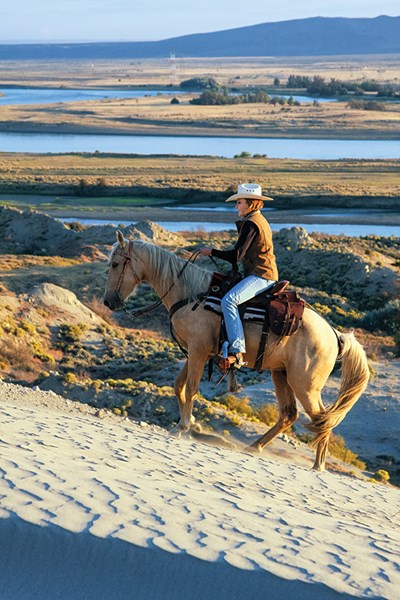
Dan Aadland raises mountain-bred Tennessee Walking Horses and gaited mules on his ranch
in Montana. His most recent books are In Trace of TR; The Best of All Seasons; The Complete
Trail Horse; and 101 Trail Riding Tips. In Trace of TR recently received a first-place Excellence
in Craft Award in the book/e-book category from the Outdoor Writers Association of America.
For information on Aadland’s horses, books, and clinics, visit http://my.montana.net/draa.






